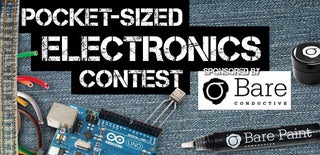Introduction: Liquid Crystal Display for the QuickStart Board
Three-Wire Liquid Crystal Display for the QuickStart
Parts Reqd:
Parallax QuickStart board
Parallax 2-line LCD display module
3-wire Interface cable - made from:
a computer front panel cable
three pins from a strip pin header
small heat shrink tubing.
Tools:
Needle nosed pliers
Soldering iron
Steady hands
The cable is the heart of this project.
Pictures below show how it is made.
I used a surplus 3-wire computer cable for my project.
It has a female connector on one end and LEDs and a switch on the other end.
The LEDS and switch were removed, and individual pins were soldered on there.
To make the cable:
Cut the cable to the desired length.
Strip the ends.
Tin the ends of the wire and trim to length to match the pin headers.
Tin the top part of the pin headers.
Slip a short piece of heat shrink tube over each of the wires.
Solder the wires to the pins by laying the tinned wire along side the pin
and touching with a hot well-tinned soldering iron.
Slide the heat-shrink tube down over the soldered connection and shrink it.
Clip the pins apart as needed.
Software:
The Parallax Propeller chip was designed with eight processors (called COGS),
any of which can be used to create software driven peripherals.
All files needed are in the ZIP file of this Instructible.
This project uses a software driven serial port to talk to the LCD display.
The driver is called Full_Duplex_Serial.Spin, but we will only be using the
transmit side, because the LCD display can not talk back.
On the back of the LCD module are two dip switches that set the baud rate.
Match these to the speed of the software serial driver is.
My example is set to 9600 baud.
In the example demo program, note how the LCD driver is started.
LCD.start(TxPin, TxPin, %1000, 9_600)
We define TxPin as pin 0 in the demo program CONstant section.
In the driver itself the parameters are received as:
Start(rxPin, txPin, mode, baudrate
Back in hardware land, note the interface cable connector. The LCD needs 5VCD.
3.3 volts, like the Propeller chip uses, just won't do. So we will use Vin on
the QuickStart board to power the LCD.
Vin, from a USB port or USB wall wart should be right at 5 volts.
All that's left is to hook it up, load the software, and get 'er running!
For YOUR project you will need to write some new code to do what you want.
For more information on the LCD module go to:
http://learn.parallax.com/kickstart/27977
For more information on the Infrared decoder chip go to:
http://www.adafruit.com/datasheets/tsop382.pdf
And to learn more about the Propeller Chip itself, stop by the Propeller Forums at:
Datasheet: http://www.adafruit.com/datasheets/tsop382.pdf
The Spin language is very straight forward and easy to learn.
But if you prefer, there are C compilers, Forth interpreters, BASIC compilers,
and a host of other languages for the Propeller chip.
Pick one and run with it.
Richard
Attachments

Participated in the
Pocket Sized Electronics














